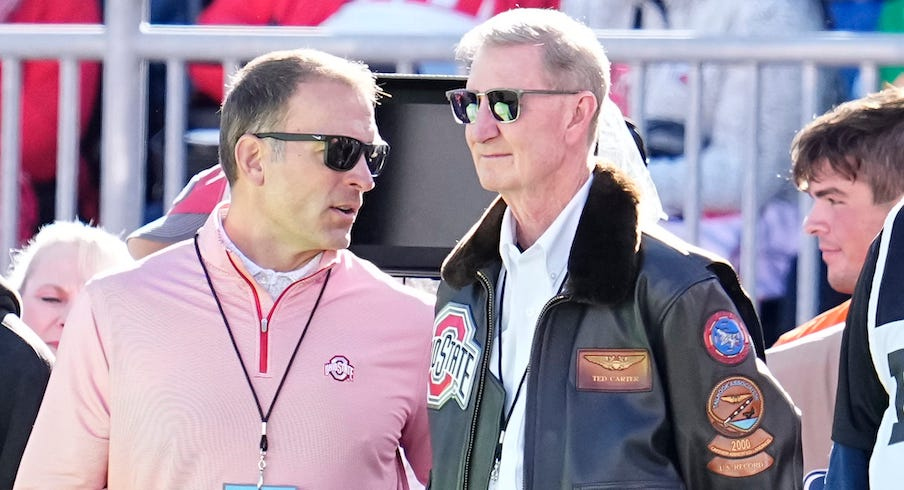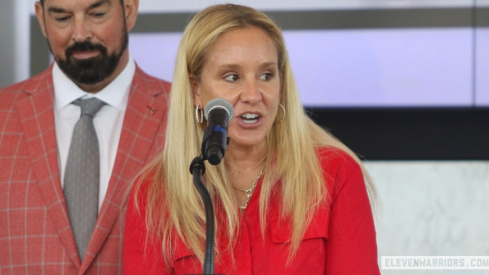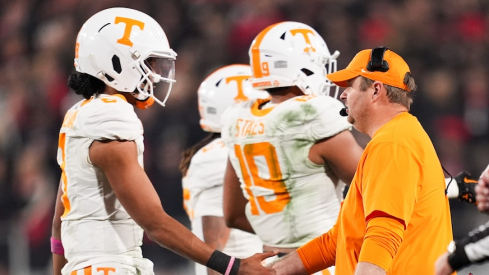Ohio State will continue to provide scholarships for all 36 of its sports.
Ohio State president Ted Carter made that declaration on Friday while laying out his 10-year plan for the university as part of his investiture ceremony, in which Carter was formally sworn in as Ohio State’s president.
“When I hired (athletic director) Ross Bjork, he and I decided right away that we would retain all 36 Division I sports programs,” Carter said. “It's important. We have over 1,000 student athletes. It's important for our Olympic sports that we do this. Not many other schools are going to be able to do this. And we will remain financially self-sufficient. That's no small order, because we're going to be sharing a fair bit of our revenue with our student-athletes. And finally, we're going to retain scholarships for all 36 Division I sports.
“We will determine how best to do that. There's a lot of big decisions to be made. But these decisions will help shape the conversation about how we can make sure that our student-athletes remain students first.”
Both Carter and Bjork have said repeatedly since Bjork’s hiring in January that they are committed to keeping all 36 of Ohio State’s varsity sports. Carter, who started his tenure as OSU’s president in January, told Eleven Warriors this summer that he was confident the athletic department would remain self-sufficient even as its expenses are set to increase next year when colleges are permitted to begin sharing revenue with athletes. Bjork has said Ohio State will share the maximum amount of revenue with its athletes; that number is projected to start at $20.5 million for the 2025-26 academic year, Yahoo Sports’ Ross Dellenger reported last week.
Whether Ohio State would continue to fund scholarships for all 36 of its sports had been called into question, however, as Bjork said this summer Ohio State might not be able to continue funding all of its non-revenue-generating sports at the same level it currently does. During an interview with Eleven Warriors in August, Bjork said how many scholarships it funds for each sport could be a “moving target” as OSU decides how to balance its spending between scholarships, revenue sharing and NIL, also indicating that there could be athletes who receive shared revenue instead of a scholarship.
Carter’s comments on Friday, however, indicate that Ohio State is committed to funding at least some scholarships for all 36 sports. That commitment goes hand in hand with Carter’s desire for Ohio State’s athletes to flourish not only in their respective sports but in the classroom. And while the landscape of college sports is about to change significantly with the implementation of revenue sharing, Carter believes it is important for the student-athlete model to remain in place.
“They're all going to be professionals, but very few of them will be professionals in athletics,” Carter said. “We're one of the top academic performing athletic departments in the country ... the GPA of all of our student-athletes across the board is over 3.3. This is exceptional. A 94% graduation rate. We are top 10 not only in what we do on the field, on the court, in the pool, but in the classroom. And I think that it is so important that we hold on to the student-athlete model, because if we lose it, and the student-athletes get titled employees, then we won't have student-athletes anymore, and we will be farm systems for other sports programs.”
Athletics is one of six themes of Education for Citizenship 2035, Carter’s 10-year strategic plan for the future of Ohio State. He felt it was important to include athletics as one of the themes of his overall strategic plan for the university because he views it as “the front porch of the university,” and he recognizes how much Ohio State sports mean not only to the university but the entire state of Ohio.
“It is the one thing that brings all Ohioans together. Regardless of what school you went to, you're a Buckeye if you're in the state of Ohio,” Carter said. “And maybe more importantly, the landscape of collegiate athletics is changing so quickly, something has probably happened while I'm talking that we'll have to deal with. The future of shared revenue, name, image, and likeness, the transfer portal; for an institution that is the largest athletic department of any major university in the country, with 36 Division I programs, we need to be a leader, we need to be a voice in protecting the student-athlete model for collegiate athletics.”


